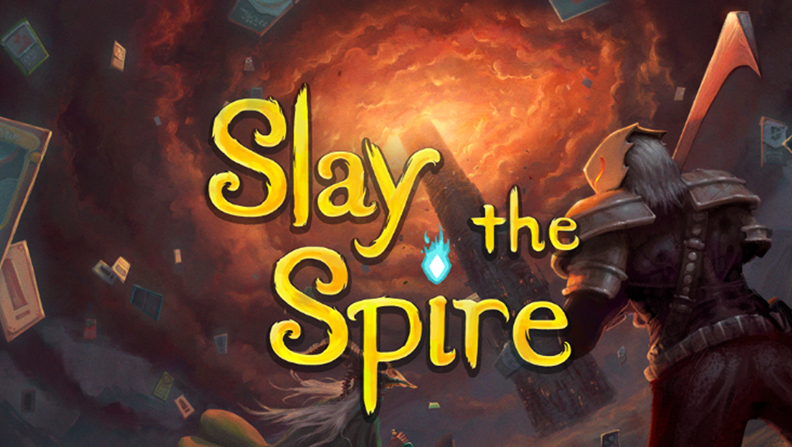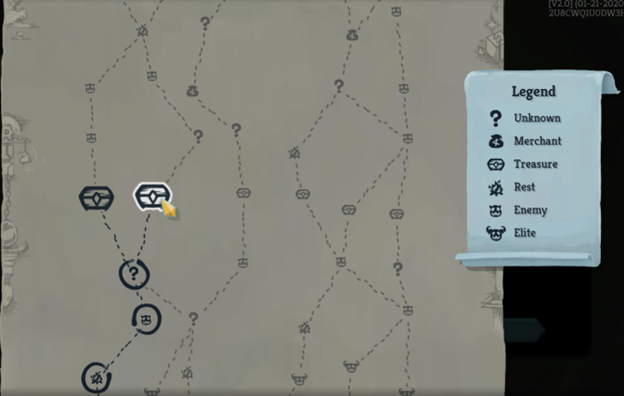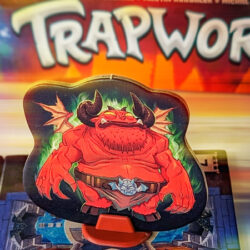
About Slay the Spire
Slay the Spire (StS) is a roguelike deckbuilding dungeon crawler. Your goal is to build a deck of cards to defeat progressively harder enemies. If you die, you’ll have to start over from the beginning. The game has an incredible amount of depth for an indie game made by two developers and has sparked many copycats. I and many others have put thousands of hours into this game and keep coming back for more with every run feeling unique. It’s a tough game to write a succinct guide for because every heuristic will have exceptions, but that’s also what’s so great about it (and is one of the similarities it has with trading). While the game can feel random at times, what keeps me going is knowing that the best players will never lose a run on the lowest difficulty settings, so there is always room to improve!
Goals of the game
In StS, the goal is to make your character and starter deck strong enough to survive the future challenges the spire throws at you. If you die, it’s back to the beginning, so that often means prioritizing short term strength over long-term strength. You don’t need a perfect deck to beat the final bosses, so you’ll end up with a higher overall winning percentage if you’re making it there 60% of the time with a scrappy deck than 20% of the time with a perfect deck.
Ways to get stronger
Improving your deck
The biggest factor in your success is the quality of your deck. There are many ways to improve your deck including: adding good cards, adding cards that synergize with existing cards in your deck, upgrading cards, and removing cards to improve your average draw. Choosing which cards to add to your deck is the hardest type of decision in the game. Tier lists or statistics available online can be helpful, but context matters massively. There is no card I would take over any other card in every situation; it’s not that kind of game.
Acquiring relics
Relics give a wide variety of persistent bonuses to your character. There’s too much variety here to cover succinctly, but know that relics tend to be better than a card reward or card upgrade.
Acquiring potions
Potions provide a one-time benefit that can help you get through a tough fight. Having some can give you the confidence to take an elite fight instead of a hallway fight (more on that difference later). Potions are often neglected by new players because they are just one more mechanic to worry about, but they are key to success, especially when a fight asks something of your deck that you’re not prepared to answer!
Increasing your health
0 health means your run is over, so one should not neglect health. Resting and regaining health may be your only hope of surviving a difficult encounter. The spire will present you with many opportunities to convert health into another form of strength so it’s good to start thinking about health as a resource.
Choosing a path and the different rooms

The first decision you’ll have to make in your initial run is which path to take. In general, I rank them as follows:
- Elites
- Shops (assuming you have more than 200 gold)
- Rest sites
- Hallway fights
- ? Rooms
Hallway fights and ? rooms are pretty close; you want a mix of both as the more you take of each the worse they become. It’s good to pick a path with some optionality. A path that forces you to take 3 Elite fights in a row with no Rest Sites is likely to lead to your demise.
Hallway fights
The most common floor in StS is the Hallway Fight. The first couple in each act are easier than the rest and they all offer the following rewards: A choice of 3 cards to add to your deck, a chance at a potion, a small amount of gold.
Elites
Risk/reward is the essence of any Roguelike and Elites are the prime example of them. They’re significantly harder than Hallway Fights but offer the same rewards plus a relic and some extra gold. They’re the primary means of acquiring relics.
Shops
Shops offer the ability to buy cards, buy relics, buy potions, and remove cards. With so many choices it’s tough to figure out the optimal play. They’re the primary means of removing cards from your deck.
Rest Sites
At rest sites you can either heal or upgrade a card. I’m generally hoping to only heal 0-1 times per act, though I’m not always so lucky.
? Rooms
These rooms are quite random. They are mostly ‘events’ where you must make some risk/reward decision. The reward is almost always worth the risk. They can also be Hallway Fights, Shops, or Treasure Rooms.
Treasure Rooms
These provide a relic and sometimes some gold. You’ll always get one of these at the halfway point of the act no matter which path you take.
Deck composition
I break down cards into 5 categories. If you’re not sure what your deck needs, consider which of these you are lacking:
Upfront Damage
Cards that deal damage but don’t deal more the longer the fight lasts
Scaling Damage
Cards that deal more damage or help you deal more damage the longer the fight lasts
Upfront Block
Like upfront damage but for block
Scaling Block
I think you get the idea
Acceleration
Cards that help you play your other cards more often by drawing them or help you play more of them by increasing how much energy you have. These aren’t great when all you’re accelerating into is Strikes and Defends but they’re the main thing you want once you’re good at all the other things.
Goals in a run
The Spire will ask many things of you throughout the run but at a very high level here are some tips to get you your first victory:
- Act 1 elites and bosses are best defeated by dealing more damage than the starter deck. If I’m going to fight an early elite, I will almost always take the first couple damage dealing cards I’m offered.
- Act 2 elites are some of the harder fights in the game and there is no shame in skipping them in favor of getting a couple more card rewards or potions before attempting one.
- Act 2 bosses are a check to see if your deck can scale up damage through the course of a fight. The first character you play, the Ironclad, most commonly does this by gaining Strength.
- Act 3 bosses ask something specific of your deck. I’ll let that be a surprise but it’s a good idea to go into them with three potions!
Slay The Spire Wiki | Fandom. (n.d.). Retrieved October 18, 2023, from https://slay-the-spire.fandom.com/wiki/Slay_the_Spire_Wiki
Interface In Game. (2020, December 11). Map - Slay the Spire | Interface In Game. Interface in Game. Retrieved October 18, 2023, from https://interfaceingame.com/screenshots/slay-the-spire-map/




Subscribe Now
Get each new post sent straight to your inbox